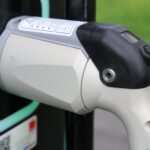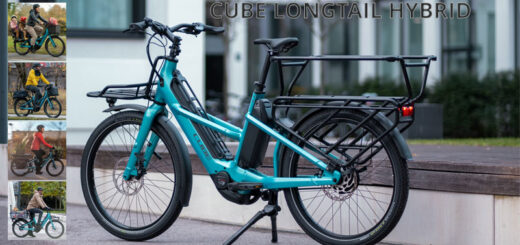E-bike batteries versus nature

E-bikes make it much easier to get around on two wheels. Those who have to ride far and climb steep hills often only switch to a two-wheeler thanks to the motor assistance. Regardless of the reason for e-biking and the type of e-bike we use, we think we are on the safe side compared to car drivers.
We use a cargo bike to transport heavy goods or our rascals to kindergarten, experience extensive routes on holiday in the midst of lush nature and explore the beautiful sides of Germany … yes, the reasons for using a bike are many and varied. At the same time, we ask ourselves what exactly our battery actually means for Mother Nature.
Cyclists are generally perceived as environmentally conscious people who at least want to do something good for themselves. Often, the demands of a passionate cyclist are even higher. He remembers reports on the Anthropocene, sees the images of man-made exploitation right in front of him ..
50 kilograms of metal come to one square metre of land. This is how immensely we have already conquered our earth with our technosphere and created a true monster with it that devours plant and animal species.
Various figures on the subject are downright frightening; after all, we are increasingly displacing the life-sustaining biosphere at an alarming rate. In doing so, we are ultimately robbing ourselves, the human species, step by step of its foundation and preventing future generations from growing up healthy and carefree.
The extinction of species, the shrinking of the rainforest … anyone who delves into the subject will quickly realise that the time for action is long overdue. All those who realised this years ago and have changed their lives would like to think that e-bikes are eyewash and that it is better to do without batteries if one is already using the environmentally friendly little bike. But have critics really informed themselves comprehensively and without bias?
Where does the white gold come from? Or: The dark side of the battery
In the Atacama Desert in South America or in the Salar de Uyuni, a Bolivian salt pan, lie some of the largest lithium deposits on earth. In such arid regions, the coveted raw material can only be extracted using a lot of water. Water – an essential element that is stolen from the population there, which is why there are more and more riots and uprisings against the mine operators.
The extraction of cobalt turns out to be just as problematic. Among other things, it is mined illegally by children, and documents on the extraction of raw materials and ultimately on battery production are not even worth their weight in paper; after all, there are no inspections by the relevant authorities and no necessary certifications. Unfortunately, the extraction of raw materials must therefore be considered a dirty business ..
The inner workings of a battery
An e-bike battery consists of several cells. Energy is exchanged within their layers, and it is precisely for these processes that the above-mentioned raw materials are absolutely necessary.
More about the structure:
A positive cathode consists of a lithium metal oxide. This lies on an aluminium foil in the battery. In contrast, the negative anode, which consists of graphite, is placed on a copper foil. During the battery charge, the lithium ions reach the anode and accumulate in the graphite. As soon as the battery releases energy, the lithium ions migrate back again.
The exchange takes place within a highly flammable electrolyte liquid. To avoid a short circuit, the anode is separated from the cathode by means of a separator foil. Only the lithium ions can penetrate this foil.
How long can I use my battery?
After an average of five years, i.e. around 700-1000 charging cycles, an e-bike battery is old-fashioned and needs to be replaced. The resources consumed in the production of ion batteries, as well as their disposal, seem to some critics to be at odds with environmentally friendly locomotion.
How do I get rid of it?
The right way to dispose of a rechargeable battery is to take it to a specialist dealer – free of charge. Selected municipal collection points, such as recycling centres, will also take your old industrial batteries free of charge. This is the only way to recycle the valuable materials. These include nickel, copper and cobalt. Recovery takes place either during a hydrometallurgical or pyrometallurgical process.
If you want to do everything right – for you and your environment, then ..

… think carefully about what you need your e-bike for before you buy it:
- For example, do you have steep gradients on the cycle path to work?
- Take advantage of the advice of a specialist dealer and buy it from a specialist.
- Don’t just buy any cheap e-bike with any battery, because only with the BATSO safety seal are you really well advised.
- Make it difficult for thieves and go for a lockable battery that can be charged separately from the bike.
- If possible, use green electricity for charging.
- Store your battery correctly. It does not like extremes, such as direct sunlight.
- It feels most comfortable at temperatures between 10 – 15 °C. So it is best to store it at these temperatures. So it’s best to store it at these temperatures to prolong its life.
- Do not simply throw an old battery in the household waste, but have it disposed of properly by your dealer.
- If you then get on your bike as often as possible instead of in your car, you can be really proud of your environmentally friendly contribution.
- Maintain your e-bike regularly.
Our first conclusion:
The topic of the battery is definitely an environmental issue; after all, in terms of consumption, its manufacture can be equated with 500 to 1000 kilometres of motorway driving, and not everyone handles their battery in an exemplary manner. Those who disregard the manufacturer’s specifications are ultimately more likely to need a replacement, but if the consumption of these expensive energy storage devices is too high, the consumer is acting contrary to his or her good intentions. However, as soon as 165 kilometres are covered by e-bike instead of by car, you can already put a big green tick behind the point “My personal eco-balance”. Every additional kilometre directly benefits the environment. That puts a big smile on the faces of us e-bikers.
The fact check: an e-bike can only be truly ecological under certain conditions!
Is that true?
What others expect of us is obvious: it is best to use the e-bike instead of our car. If we leave our e-bike in the garage, of all places, our eco-balance will certainly be lousy. The choice of how strong the motor support should be is also decisive: whether we are aiming for 45kmh or “only” 25kmh.
When buying an e-bike, it is important to consider what it will be used for. Do we just want to be part of the new trend par excellence or do we have really ambitious plans? We can only answer these questions for ourselves, and the answers to them will determine whether we ultimately contribute something to environmental protection with our e-bike purchase or rather have the opposite effect.
The advantages are obvious:
Whether we use our e-bike in the city or in rural areas, it will be unbeatable in terms of travel costs. An e-bike can also be parked almost anywhere, and those who used to struggle through the traffic jams after work will be surprised how quickly they can now get around on an e-bike – far away from the smelly traffic jams. With e-bikes, we neither make noise nor pollute the air, and we will never hitdeer or even run oversquirrels and cats, not to mention the many plus points for our health and the good example for everyone who sees us pedalling on an e-bike.
The fact is: the savings made by replacing car journeys are enormous and make all the difference.
Put to the test ..
It is realistic, albeit pessimistic, to cover at least 50 km with a 500 Wh battery. We’ll leave the Eco mode out of it for now and make it extra difficult for ourselves by assuming bad conditions. Thanks to the popular range calculator – for example the one from Bosch – we calculate one kilowatt hour of energy consumption for 100 km. That would correspond to CO2 emissions of less than 480g. In comparison, a small car emits 23 times as much! Larger cars, on the other hand, are the clear losers with almost 120 times the environmental impact.
The German Institute of Urban Affairs (Difu), thanks to its data on the ratio of the energy balances between e-bikes and cars – namely with the value 1:30 – makes the overwhelming winner clear.
No matter how we spin it: All in all, an e-bike always performs better than any car, no matter how small, and even beats slim motor scooters. On average, we are talking about a value of 1:5, which means that in ecological terms an e-bike is five times more environmentally friendly than public transport! That’s worth an appreciative “Wow!”, isn’t it?
After about 100 pedelec kilometres compared to a car, the greenhouse gas emissions of the battery are already balanced out.
The disadvantages of the battery are simply the raw materials it contains, some of which have been mined abroad in appalling conditions, which affects both people and nature. However, research is being carried out into solutions, so we will certainly hear about new advances in this area soon.
It is interesting to note that 80 percent of e-bikers use their vehicles sustainably instead of other means of transport with higher emissions. The other 20 percent have simply switched from cycling to e-biking. The latter is indeed not very sustainable, but the bottom line is that the balance is still fully in the green. So we turn our attention to further accusations and nip them in the bud:
Thanks to the IFEU (Institute for Energy and Environmental Research), we have extensive data to prove that no aspects have been left out. Neither weather conditions nor the gender of the users. In view of this comprehensive data, it is only possible to assess how good the switch to an e-bike is for our environment.
Thanks to these bikes, many people are finding that they are able to get more fresh air and do something good for their health. They connect with the outside world in a new way, and the motor assistance in no way limits their “contribution to their own health”. Commuters in particular really appreciate the exercise, as it offers a valuable change from the sedentary office routine.
According to statistics, 45 per cent of the kilometres once travelled are now pedalled on an e-bike. At best, this will save one and a half million tonnes of CO² by 2030. At the same time, developments in the area of battery technologies are being pushed forward. The infrastructure, for example in terms of cycle paths, is also being steadily improved; after all, demand is rising.
Two unbeatable advantages are:
- By means of increasing renewable energies, emissions in e-bike production and use will continue to decrease.
- E-bikes significantly expand the possible uses of the two-wheeler and will certainly open up new possibilities for us in the future.
Even the most dogged critics will have to realise:
Electric bikes are the alternative to the car. Five or even twenty kilometres can be covered quickly by cycling. Especially in comparison to a car, we save money and are more ecological, healthier, and usually also faster and more space-saving on the road. Only compared to a normal bicycle do “electros” come off worse in terms of purchase and operation.
E-bikes with their manifold possibilities will continue to connect more people with the developed cycling networks in the future.
We are sure: With your and my e-bike, we are moving forward, into a greener future!



















Recent Comments